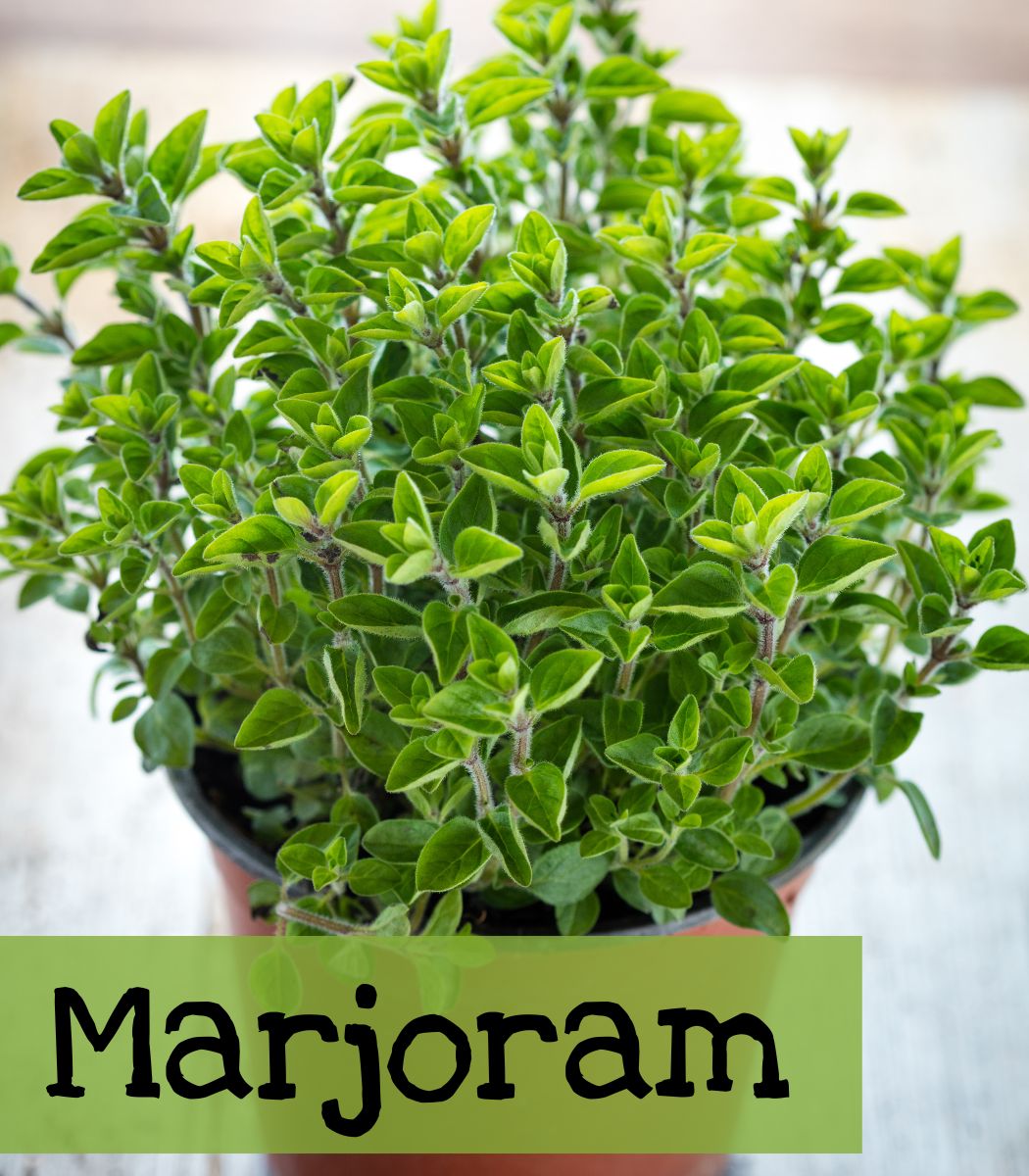
Marjoram
Used in stews, roasts, and stuffing, this relative of oregano has a milder flavor. Marjoram leaves can also be steeped and made into a flavorful tea and the plant has been used medicinally (though not many modern studies have been done proving health benefits).
|
Sweet Marjoram |
|
Majorana hortensis also known as Origanum majorana |
|
Easy to Intermediate |
|
Intermediate to Difficult |
|
3 years if properly stored |
|
Annual Perennial is zones 9-10 |
|
7-14 days |
|
None |
|
Surface Sow |
|
12 inches |
|
Needs light to germinate Full sun |
|
Feb, Mar |
|
Yes |

Growing Tips



When to Start
Spring: Start indors 6-8 weeks before the last frost. (Late Feb-Mar for Jefferson, GA)
Direct Sow: DO NOT sow in frost conditions. Sow after ALL danger of frost has passed. (May 1 for Jefferson, GA)
How to Grow
Start indoors 6-8 weeks before the last average frost in your area. Surface sow marjoram, as the seeds need light to germinate, into seed starting mix. Place cells or nursery pots under grow lights. Keep the soil moist but not soggy. Marjoram prefers soil temps to be 70 F to germinate. A heat mate may be needed.
To direct sow, wait until ALL danger of frost has passed and the soil has warmed to an average of 70 F. NO NOT plant when there is a possibility of frost. (Wait until May 1 for Jefferson, GA.) Choose a full sun bed and gently press the seeds into the top of the soil to keep the wind from blowing them away or barely covering them with soil. Keep the soil moist, but not soggy. Space or thin to 6-12 inches apart.
Care
Like most herbs, Marjoram can be grown in window boxes or other containers. It likes well-draining soil on the dryer side and 6-8+ hours of sun. Let it dry out between watering as it hates wet feet. It thrives in conditions where the highs are in the low 70s F and the lows are in the 60s F. As temperatures increase during the summer, afternoon shade will benefit the plant. The plant also struggles in humid climates. When living in an area that has high humidity, make sure the proper spacing is observed and plant it where it will get good air circulation to help reduce issues. If it still struggles, consider making it a house plant.
As a tender perennial, the plant will grow well for 2 years. After 2 years marjoram will become woody and the taste of the leaves will change. Replant every 2 years or treat it like an annual. You can grow from cuttings, if you do not wish to start from seed.
Harvest
Cut when the sprigs are 4-6 inches long. For the best flavor, harvest in the morning and before it has started to flower. Harvest can be extended by pinching off buds.
How to use
Marjoram is excellent in flavoring chicken and pairs well with lemon. It is used to season eggs, soups, and sauces. It can even be used in potpourri.
To make tea: Add 1 teaspoon of fresh leaves or 1/2 teaspoon dried to 1 cup of boiling water. Let steep to the desired strength and then strain the leaves. Mix it up by adding it to a cup of black tea.
Pro Tip!
Incompatibles: Cucumber
Grows well with: Sage, and most vegetables (It is said to improve the flavor of vegetables.)
Seed Saving


Cuttings

Isolation Distance
Marjoram is pollinated by wind, insects, and birds. All marjoram will cross with other marjoram and oregano. Isolate 1-2 miles from other marjoram or oregano.
Instructions
As marjoram will cross with other marjoram and oregano the easiest way to propagate would be through cuttings. For seed saving bag blooms and hand pollinate.
To propagate through cuttings
- Use sterile scissors.
- In late spring or early summer, choose healthy sprigs at least 4 inches long and that have several sets of leaves on them.
- Fill a jar or cup with clean water and place individual cuttings into separate jars.
- Place jars where they will get plenty of bright indirect light.
- Change the water every few days until roots start to form. This process takes about 2 weeks.
- When the roots are several inches long, gently remove the cuttings and transplant them into pots.
- Water in.
To propagate through saving seeds
- Bag buds before they open to prevent cross-pollination. Hand pollinate flowers (you might need a small paint brush). Then re-bag the blooms.
- Seeds are mature when flower heads have completely dried and turn brown.
- Cut flower spikes and place them in a paper bag or spread evenly on a tray.
- Allow the seeds to completely dry and drop, shaking the bag to loosen seeds.
- Separate chaff from seeds and store in a cool, dry place.
Features
- Culinary
- Container friendly
- Attracts pollinators
- Fragrant
- Drought tolerant
- Good dried
Sweet Marjoram: Heirloom. Very similar to oregano and can be used substitute for that herb. The leaves are good fresh or dry and flavor soups, salads, dressings, meats, beans, susage, and lamb dishes.

Do NOT plant when there is a danger of frost.
Sources:
The New York Botanical Garden, Herbal Handbook, Clarkson Potter.
Helmer, Jodi. Growing Your Own Tea Garden: the Guide to Growing and Harvesting Flavorful Teas in Your Backyard. Fox Chapel Publishers International Ltd., 2019.
Edenbrothers.com
